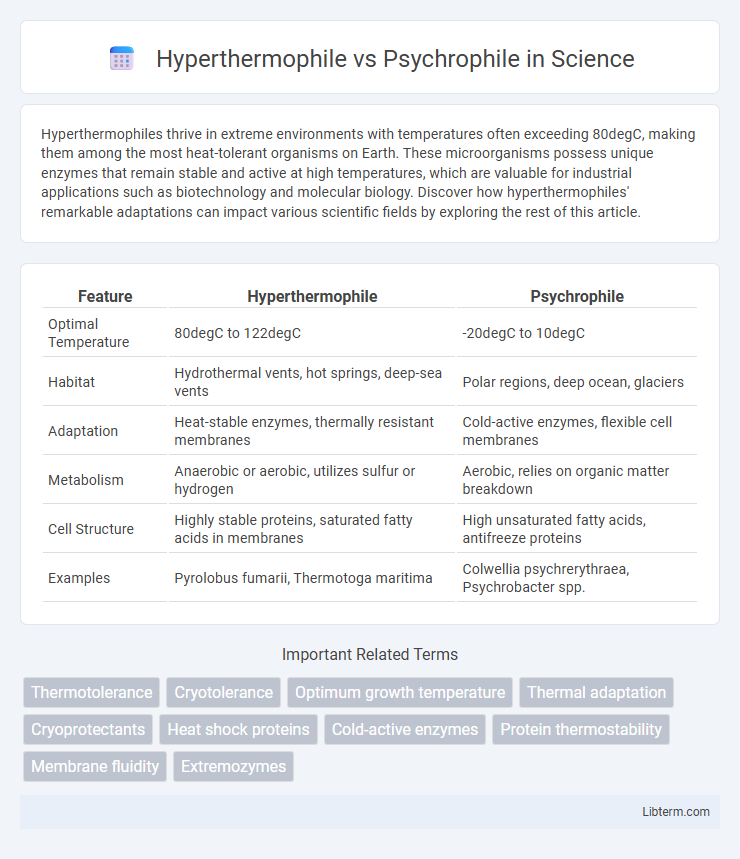Hyperthermophiles thrive in extreme environments with temperatures often exceeding 80degC, making them among the most heat-tolerant organisms on Earth. These microorganisms possess unique enzymes that remain stable and active at high temperatures, which are valuable for industrial applications such as biotechnology and molecular biology. Discover how hyperthermophiles' remarkable adaptations can impact various scientific fields by exploring the rest of this article.
Table of Comparison
| Feature | Hyperthermophile | Psychrophile |
|---|---|---|
| Optimal Temperature | 80degC to 122degC | -20degC to 10degC |
| Habitat | Hydrothermal vents, hot springs, deep-sea vents | Polar regions, deep ocean, glaciers |
| Adaptation | Heat-stable enzymes, thermally resistant membranes | Cold-active enzymes, flexible cell membranes |
| Metabolism | Anaerobic or aerobic, utilizes sulfur or hydrogen | Aerobic, relies on organic matter breakdown |
| Cell Structure | Highly stable proteins, saturated fatty acids in membranes | High unsaturated fatty acids, antifreeze proteins |
| Examples | Pyrolobus fumarii, Thermotoga maritima | Colwellia psychrerythraea, Psychrobacter spp. |
Introduction to Extremophiles
Extremophiles are organisms adapted to survive in extreme environmental conditions, with hyperthermophiles thriving at temperatures above 80degC and psychrophiles flourishing in cold environments below 15degC. Hyperthermophiles, often found in hydrothermal vents and hot springs, have specialized enzymes that maintain stability and function at high temperatures. Psychrophiles inhabit polar regions and deep ocean waters, possessing cellular adaptations such as antifreeze proteins to prevent ice crystal formation and maintain membrane fluidity in freezing conditions.
Defining Hyperthermophiles
Hyperthermophiles are microorganisms that thrive at extremely high temperatures, often above 80degC, commonly found in environments such as hydrothermal vents and hot springs. These organisms possess specialized enzymes and protein structures that maintain stability and functionality despite intense heat. In contrast, psychrophiles are adapted to cold environments, preferring temperatures below 15degC, highlighting the distinct thermal adaptations of extremophilic microbes.
Defining Psychrophiles
Psychrophiles are microorganisms adapted to thrive in extremely cold environments with temperatures typically below 15degC, such as Arctic and Antarctic regions, deep ocean waters, and alpine soils. These organisms possess enzymes and cellular structures optimized for maintaining metabolic activity at low temperatures, enabling growth and reproduction in icy conditions. In contrast, hyperthermophiles are heat-loving microbes that flourish at temperatures above 80degC, often found in geothermal hot springs and hydrothermal vents.
Environmental Niches and Habitats
Hyperthermophiles thrive in extreme high-temperature environments such as hydrothermal vents, hot springs, and deep-sea geothermal habitats, with optimal growth temperatures above 80degC, often exceeding 100degC. Psychrophiles inhabit consistently cold environments including polar regions, deep ocean waters, glaciers, and permafrost, with growth temperatures typically below 15degC and some able to survive below freezing. These organisms have evolved unique adaptations that enable survival in either extreme thermal niches, influencing global biogeochemical cycles and ecosystem dynamics.
Cellular Adaptations to Extreme Temperatures
Hyperthermophiles possess heat-stable enzymes and highly saturated membrane lipids that maintain cellular integrity at temperatures above 80degC, enabling efficient protein folding and DNA stability. Psychrophiles adapt to cold environments below 15degC through increased membrane fluidity by incorporating unsaturated fatty acids and synthesizing cold-shock proteins that facilitate molecular interactions and prevent ice crystal formation. Both organisms use specialized chaperones and compatible solutes to preserve cellular function under extreme thermal stress.
Enzyme Stability and Functionality
Hyperthermophiles produce enzymes that remain stable and functional at extreme temperatures above 80degC due to their highly rigid protein structures and enhanced intramolecular interactions. Psychrophiles synthesize enzymes optimized for activity at low temperatures, typically below 15degC, featuring increased structural flexibility to maintain catalytic efficiency in cold environments. The contrasting enzyme adaptations enable hyperthermophilic enzymes to resist denaturation and psychrophilic enzymes to facilitate biochemical reactions in temperature extremes.
Genomic and Molecular Mechanisms
Hyperthermophiles possess specialized DNA repair enzymes and highly stable proteins with abundant ionic bonds and hydrophobic cores, enabling their genomes to maintain integrity at temperatures often exceeding 80degC. Psychrophiles exhibit cold-adapted enzymes with increased structural flexibility, lower proline content, and higher unsaturated fatty acid concentrations in membranes, optimizing molecular function at temperatures below 15degC. Genomic adaptations in hyperthermophiles include GC-rich sequences enhancing thermal stability, while psychrophiles often have genes encoding antifreeze proteins and cold-shock proteins to prevent ice formation and maintain cellular processes.
Industrial and Biotechnological Applications
Hyperthermophiles, thriving at temperatures above 80degC, produce thermostable enzymes such as DNA polymerases and proteases that are pivotal in industrial processes like PCR, biofuel production, and high-temperature waste treatment. Psychrophiles, adapted to cold environments below 15degC, offer cold-active enzymes used in bioremediation of pollutants in cold climates, food processing to preserve freshness, and detergents that function efficiently at low temperatures. Both extremophiles enhance biotechnological applications by expanding the range of operational conditions for enzymatic reactions, improving efficiency, and reducing energy costs in various industries.
Evolutionary Significance
Hyperthermophiles and psychrophiles illustrate evolutionary adaptation to extreme thermal environments, demonstrating life's ability to diversify under temperature pressures. Hyperthermophiles possess specialized proteins and membrane structures that maintain stability and functionality at temperatures above 80degC, indicating ancient evolutionary origins linked to Earth's early hot environments. Psychrophiles adapt through antifreeze proteins and flexible enzymes, reflecting evolutionary pathways that enable survival and metabolic activity in permanently cold habitats, highlighting thermal niche specialization.
Future Research Directions
Future research directions in hyperthermophiles focus on uncovering novel thermostable enzymes for industrial biotechnology and understanding their genetic adaptations to extreme heat. Studies on psychrophiles aim to explore cold-active enzymes with applications in bioremediation and medical diagnostics, while investigating molecular mechanisms of cold tolerance. Integrating multi-omics approaches promises deeper insights into extremophile resilience, potentially enabling bioengineering of synthetic organisms for climate-specific industrial applications.
Hyperthermophile Infographic

 libterm.com
libterm.com